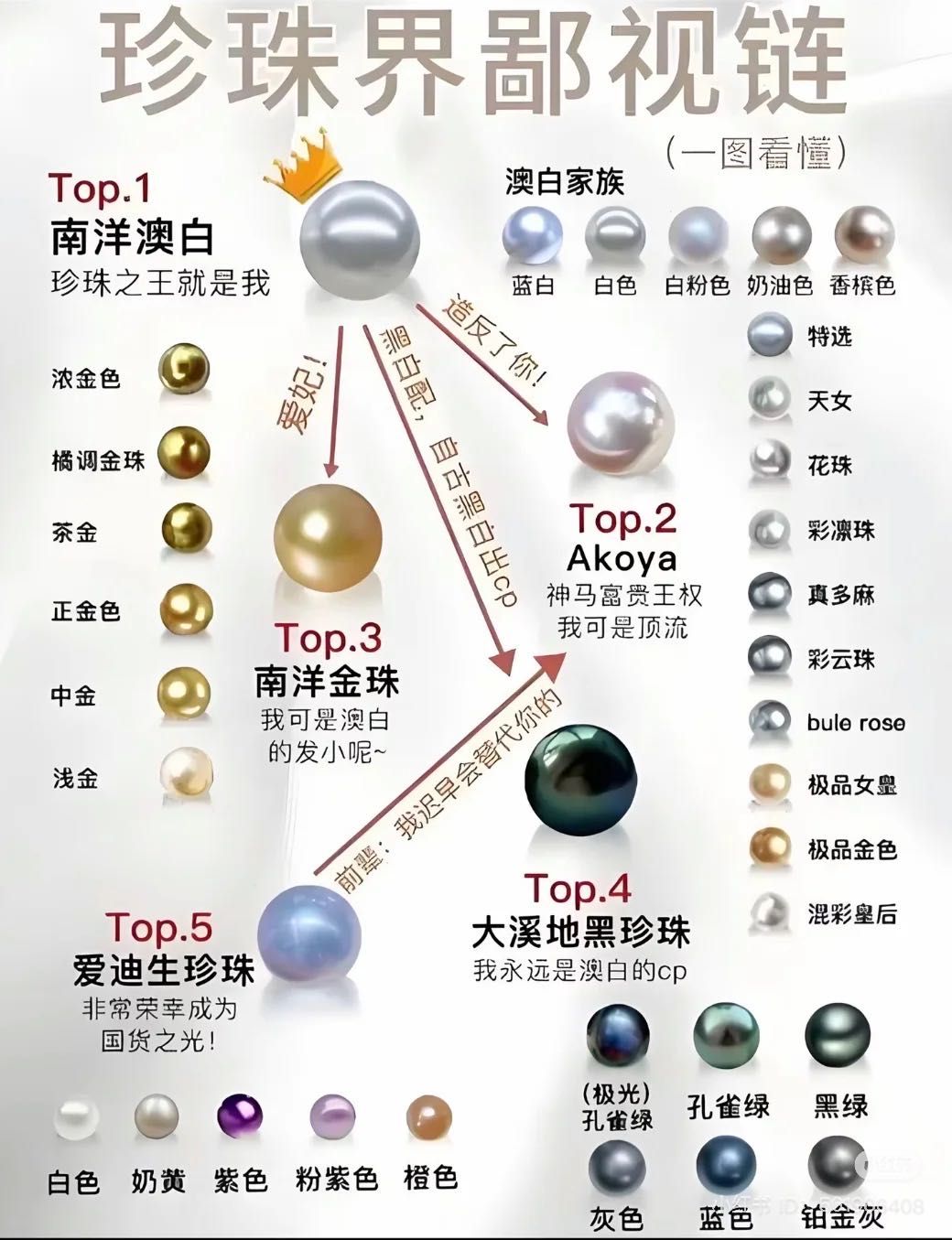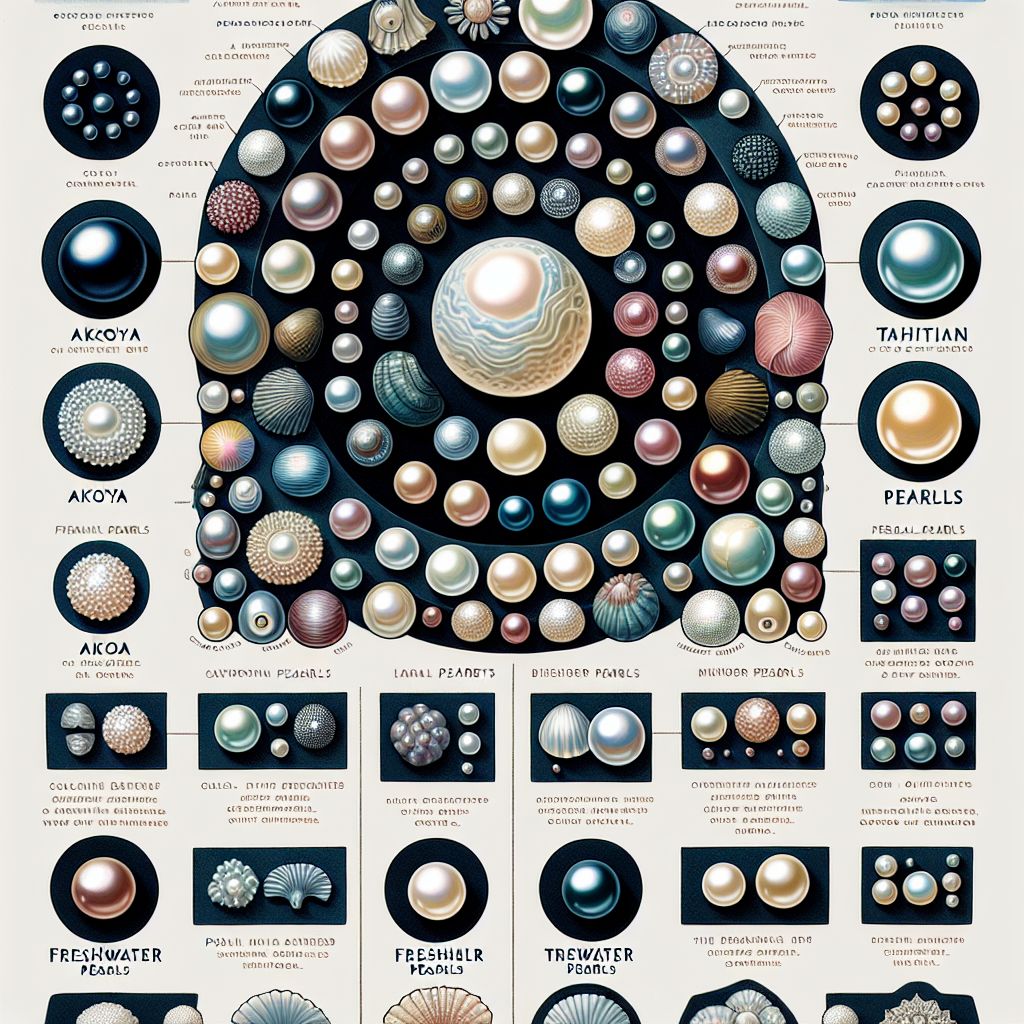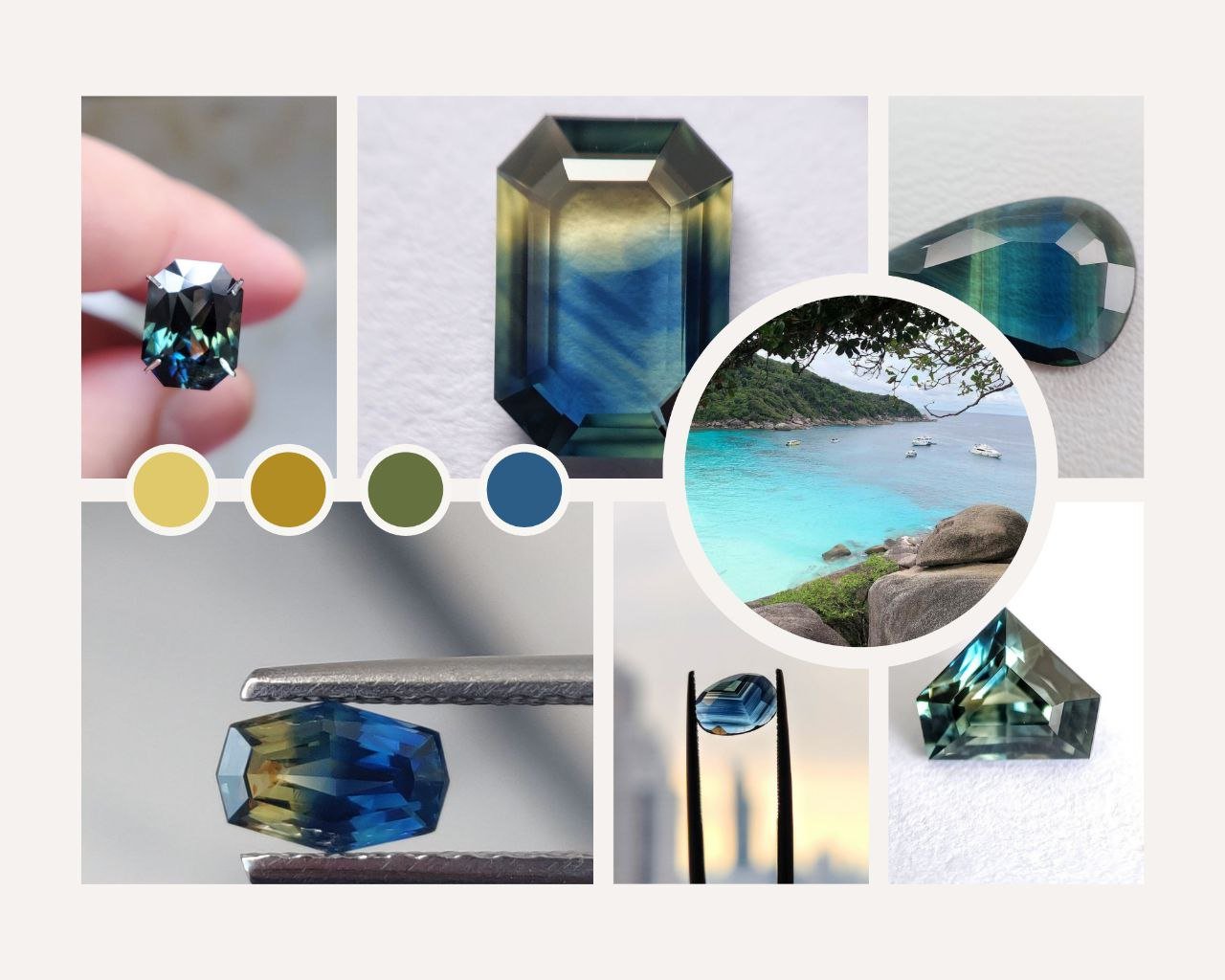Key Takeaways
- Freshwater pearls are the most affordable and come in various shapes and colors.
- Saltwater pearls include Akoya, South Sea, and Tahitian, each with unique characteristics.
- Akoya pearls are known for their classic round shape and high luster.
- South Sea pearls are the largest and often the most valuable due to their size and rarity.
- Tahitian pearls are famous for their exotic dark hues, ranging from gray to black.
Discovering Pearl Categories

Pearls are timeless treasures of the sea, cherished for their natural beauty and elegance. Whether you’re a seasoned jewelry enthusiast or a curious beginner, understanding the various categories of pearls is essential. Let’s dive into the world of pearls and discover what makes each type unique and desirable.
Freshwater Pearls: Diversity and Affordability
Freshwater pearls are often the go-to choice for those new to pearl jewelry. Why? They offer a fantastic range of shapes and colors, and they don’t break the bank. These pearls are typically cultivated in freshwater lakes and rivers, primarily in China.
What’s truly remarkable about freshwater pearls is their versatility. They can be round, oval, or even baroque in shape. Their colors range from classic white to delicate pinks, lavenders, and even deeper hues like peacock. This variety makes them perfect for crafting unique and personalized pieces.
Saltwater Pearls: Akoya, South Sea, and Tahitian
- Akoya Pearls: Known for their classic round shape and mirror-like luster, Akoya pearls are primarily cultivated in Japan and China. They are often used in traditional pearl strands and are a favorite for their elegant simplicity.
- South Sea Pearls: Cultivated in the warm waters of Australia, the Philippines, and Indonesia, these pearls are the largest and among the most valuable. Their colors range from white to golden, and their size and rarity make them a symbol of luxury.
- Tahitian Pearls: These exotic pearls are cultivated in the French Polynesian islands and are renowned for their unique dark colors. They can range from silver to charcoal and even jet black, offering a dramatic and modern look.
Each of these saltwater pearl types has its distinct charm and allure, making them sought after by collectors and enthusiasts worldwide.
Naturally Formed Pearls versus Cultured Pearls
Most importantly, understanding the difference between naturally formed pearls and cultured pearls is crucial. Naturally formed pearls are rare gems that occur without human intervention. They are incredibly scarce and often found in antique jewelry.
On the other hand, cultured pearls are created with human assistance. A small bead or piece of tissue is implanted into the mollusk, which then forms a pearl over time. This method allows for more consistent production and a wider availability of pearls in the market. Learn more about the techniques and methods used in pearl cultivation.
Both types have their place in the world of jewelry, but cultured pearls are more commonly used today due to their accessibility and affordability.
Baroque Pearls: Unique Non-Spherical Shapes
Baroque pearls are the rebels of the pearl world. Unlike their perfectly round counterparts, baroque pearls boast irregular, non-spherical shapes that are as unique as fingerprints. These pearls are often celebrated for their individuality and are used to create stunning, avant-garde jewelry pieces.
Their uneven forms can range from slightly off-round to dramatically abstract, making each piece a one-of-a-kind creation. Designers love baroque pearls for their versatility and the creative freedom they offer. Whether set in a bold necklace or a statement ring, baroque pearls never fail to capture attention and spark conversation.
Keshi Pearls: Byproduct of Cultured Pearls
Keshi pearls are an interesting byproduct of the cultured pearl industry. They form when the oyster rejects the implanted nucleus but still produces nacre, resulting in a pearl without a solid center. Because they are all nacre, Keshi pearls have a beautiful luster that often surpasses that of nucleated cultured pearls.
These pearls come in a variety of shapes and sizes, often resembling small nuggets or flakes. Despite their small size, Keshi pearls are highly prized for their exceptional shine and are frequently used in high-end jewelry designs.
Mabe Pearls: Half Pearls for Jewelry
Mabe pearls, also known as half pearls, are cultured against the inside of the mollusk’s shell, resulting in a dome-shaped pearl. This unique cultivation process gives Mabe pearls their distinct flat back, making them ideal for use in settings like earrings and pendants.
These pearls are typically larger than other types and can exhibit a range of colors, from white and cream to pink and blue. Mabe pearls are a popular choice for designers looking to create bold, eye-catching pieces that showcase the pearl’s natural beauty.
Assessing Pearl Quality
When it comes to pearls, quality is everything. Understanding the factors that affect a pearl’s value can help you make informed decisions when purchasing or evaluating pearls. Let’s explore the key elements that determine a pearl’s worth.
Factors Affecting Pearl Value
Several factors influence the value of a pearl, including size, shape, color, luster, and surface quality. Each of these characteristics plays a role in determining the overall appeal and price of the pearl.
- Size: Generally, larger pearls are more valuable due to their rarity.
- Shape: Perfectly round pearls are the most sought after, though unique shapes like baroque have their own charm.
- Color: While white and cream are classic, rare colors like black or gold can significantly increase a pearl’s value.
- Luster: This refers to the shine and reflection on the pearl’s surface; higher luster means higher value.
- Surface Quality: Pearls with fewer blemishes or imperfections are more desirable.
Luster: The Hallmark of Quality Pearls
Luster is perhaps the most important factor in assessing pearl quality. It’s the way light reflects off the pearl’s surface, creating that signature glow. A pearl with high luster will have sharp, bright reflections and a deep, almost mirror-like shine. For more insights, you can explore why Broome Keshi pearls matter and how their unique characteristics contribute to their value.
When examining a pearl, look for clear, crisp reflections. The better the luster, the more valuable the pearl. Keep in mind that luster can vary between pearl types, with Akoya pearls often having the highest luster among cultured pearls.
Surface Quality: Imperfections and Their Impact
No pearl is perfect, but the fewer the imperfections, the higher the pearl’s quality. Surface blemishes can include spots, bumps, or rings, and while they add character, they can also decrease a pearl’s value.
When assessing surface quality, it’s important to consider the size and visibility of imperfections. Small, less noticeable blemishes are often acceptable, especially if the pearl’s luster is exceptional. However, significant imperfections can detract from the pearl’s beauty and value.
Purchasing Pearls: What to Consider
Buying pearls can be an exciting yet daunting experience. With so many options available, it’s crucial to know what to look for to ensure you’re making a wise investment. Here’s what you should keep in mind when purchasing pearls.
First and foremost, consider the type of pearl you want. Are you drawn to the classic elegance of Akoya pearls, the exotic allure of Tahitian pearls, or the unique charm of baroque pearls? Understanding your preferences will help narrow down your choices.
Next, set a budget. Pearls can range in price from affordable freshwater varieties to high-end South Sea pearls. Knowing your budget will help guide your decisions and prevent you from overspending.
Understanding Pearl Grading
Pearl grading can be a bit confusing, but it’s essential for understanding a pearl’s quality. Grading systems vary, but they generally assess factors like luster, surface quality, shape, and size. For those interested in learning more about ethical sourcing, you might want to explore GIA certified ethically sourced gems.
For instance, the AAA-A system is commonly used, with AAA representing the highest quality. When buying pearls, ask the jeweler about the grading system they use and what it means for the pearls you’re considering.
Budgeting and Making Informed Choices
Budgeting is key when purchasing pearls. Determine how much you’re willing to spend and stick to it. Remember, the most expensive pearls aren’t always the best choice for everyone.
Consider what matters most to you: is it the size, the color, or perhaps the luster? Prioritize these factors to find pearls that align with your personal taste and budget.
Choosing Pearls for Different Occasions
When it comes to selecting pearls for different occasions, consider the formality and style of the event. For everyday wear, freshwater pearls offer a casual elegance that’s both versatile and affordable. Their variety of shapes and colors can complement any outfit, making them a staple in any jewelry collection.
For formal events, such as weddings or galas, you might opt for the timeless beauty of Akoya or South Sea pearls. These pearls exude sophistication and are often associated with luxury. A classic strand of Akoya pearls or a statement piece featuring large South Sea pearls can elevate your ensemble and leave a lasting impression.
If you’re attending a modern or avant-garde event, Tahitian or baroque pearls can make a bold statement. Their unique colors and shapes can add an element of surprise and creativity to your look, ensuring you stand out in the crowd.
Caring for Your Pearls

Pearls are delicate gems that require special care to maintain their beauty and luster. Proper care not only preserves their appearance but also ensures they remain a cherished part of your jewelry collection for years to come. For more insights, explore our guide on Keshi Pearl Earrings and discover their unique charm.
Most importantly, pearls should be the last thing you put on and the first thing you take off when dressing. This simple rule helps protect them from chemicals found in cosmetics, perfumes, and hairsprays, which can damage the pearl’s surface.
Cleaning Tips to Maintain Luster
Cleaning pearls is a gentle process. After wearing your pearls, wipe them with a soft, damp cloth to remove any oils or residues. Avoid using harsh detergents or ultrasonic cleaners, as these can harm the pearls.
For a deeper clean, use a mild soap solution and a soft cloth. Gently wipe each pearl, being careful not to submerge the strand in water, which can weaken the silk thread. Rinse with a damp cloth and allow the pearls to dry flat on a soft surface. For more information on maintaining the quality of your pearls, consider these pearl farm conditions optimization tips.
Storage Recommendations to Prevent Damage
Proper storage is crucial to prevent scratches and maintain the integrity of your pearls. Store them in a soft pouch or a separate compartment in your jewelry box, away from other pieces that could cause damage.
It’s also important to store pearls in a cool, dry place. Avoid exposing them to extreme temperatures or humidity, which can cause the pearls to crack or lose their luster.
Regularly check the stringing of your pearl strands, especially if worn frequently. Restringing them annually can prevent breakage and ensure they remain secure.
Frequently Asked Questions
Understanding pearls can be a fascinating journey. Here are some common questions and answers to help guide you through the world of pearls.
What Are the Differences Between Freshwater and Saltwater Pearls?
Freshwater pearls are cultivated in freshwater lakes and rivers, primarily in China. They are known for their variety of shapes and colors, making them affordable and versatile.
Saltwater pearls, on the other hand, are cultivated in oceans and include Akoya, South Sea, and Tahitian pearls. They are generally more expensive due to their rarity and the complexity of their cultivation process.
How Do I Identify Real Pearls?
To identify real pearls, gently rub them against your teeth. Real pearls feel gritty due to the natural nacre layers, while imitation pearls feel smooth. Additionally, real pearls are heavier and cooler to the touch compared to their synthetic counterparts.
Why Are Some Pearls More Expensive Than Others?
The price of pearls is influenced by factors such as type, size, shape, color, luster, and surface quality. Larger, rounder, and more lustrous pearls with fewer blemishes are typically more valuable. Additionally, saltwater pearls are often more expensive than freshwater pearls due to their rarity and cultivation methods.
What’s the Significance of Pearl Colors?
Pearl colors can carry different meanings and suit various personal styles. White pearls symbolize purity and are traditional for weddings. Black pearls, like Tahitian pearls, are associated with mystery and sophistication. Golden South Sea pearls exude luxury and wealth.
- White pearls: Purity, innocence, new beginnings
- Black pearls: Mystery, elegance, modernity
- Pink pearls: Romance, femininity, love
- Golden pearls: Wealth, prosperity, luxury
How Should I Care for My Pearl Jewelry?
Caring for pearl jewelry involves regular cleaning, careful storage, and mindful wearing. Always put on pearls after applying makeup and perfume to avoid chemical damage. Clean them gently with a soft cloth and mild soap solution, and store them in a soft pouch to prevent scratches.
With these tips in mind, your pearls can remain a cherished part of your collection, radiating their natural beauty and elegance for generations to come. For more on how to maintain their value, check out our guide on valuing Broome Keshi pearls.



